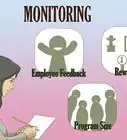This article was co-authored by Small Giants. Small Giants is a business community for purpose-driven leaders with the mission to share stories of incredible businesses and learn new practices and systems to implement in their own organizations. Each year, Forbes teams up with the Small Giants Community to identify the top 25 best small companies in America.
There are 7 references cited in this article, which can be found at the bottom of the page.
This article has been viewed 87,201 times.
Your employees not only want fair pay, but they also want recognition for their efforts. An employee recognition award program might be just what your business needs to make your staff feel valued. Any program requires careful planning, so put together a committee and obtain buy-in from senior management. You’ll need to set selection criteria and inform employees about how the program works. After running the program for a year, reassess to see if it has helped you accomplish your goals.
Steps
Planning the Program
-
1Identify the program's objectives. Your objectives should be meaningful to your organization and should reward employees for upholding your company's values. For example, you might want to encourage teamwork or innovation. Alternately, you might want the program to reduce absenteeism and increase employee retention.
-
2Get the support of management. Your recognition program will fail if it isn’t supported by senior management. Accordingly, you should schedule a meeting to discuss why you want to implement the program.
- Print off articles that demonstrate the benefits of employee recognition award programs and leave them with your boss.
- Management is usually worried about money. Explain that an employee recognition award program can be created fairly cheaply.
Advertisement -
3Create a committee. Don’t just outsource your reward program to Human Resources.[1] Instead, your committee should represent employees at all levels of the organization, including management and senior leadership.
- You can appoint a chair and then ask for volunteers to join the committee. If there’s a lot of interest, you might need to hold an election.[2]
- If you have a small business, you might not need a committee. Instead, you can work with all employees to come up with a recognition award program or just develop it yourself.
-
4Develop criteria for awards. Identify why you are recognizing people, and make sure the criteria tie in with your business’ core values, such as integrity, commitment, and excellence. Award programs generally reward the following:
- Length of service with the business. Typically, recognition is given for five-year increments (5, 10, 15, etc.) and the recipients receive certificates or plaques.
- Outstanding one-time performance. For example, a staff member might have handled an irate customer or pulled through on a big project.
- Excellent effort over time. These are your superstars who bring their A game every day.
- Other criteria. Many businesses are becoming more creative with their awards programs. For example, they are recognizing employees for building morale, volunteer work, and client retention.
-
5Survey your employees. Make sure to ask your employees what behaviors or accomplishments they think should be rewarded. This way, they will support the award program because they see that it promotes values they share. Create a survey on SurveyMonkey and distribute it to your staff.
- Also ask them how they want to be recognized. For example, do they want to attend a banquet where employees receive rewards? Or do they want a plaque on the wall with a gift certificate?
-
6Choose which awards to give. After taking into consideration your employees' preferences, you should come up with awards. Pay close attention to your budgeting constraints. Senior management will be less enthusiastic if you break the bank on awards. Consider any of the following:[3]
- Cash bonuses. You can give $25, $50, or more. These are appropriate for rewarding one-time performance.
- Small gifts. You can give movie tickets, gift cards, flowers, or T-shirts.
- Commemorative core value tokens or stickers. Give employees a laptop sticker, coin, or pin that they can display in their work space.[4]
- Public recognition. You can name someone an employee of the month and put their picture on a bulletin board. You might also hold a recognition lunch or simply praise someone in a team meeting.
- Spin the wheel. For a fun option, allow employees to spin a wheel with prizes printed on it. The wheel itself can remind employees of the award program.[5]
- Time off. You can give extended vacations or more personal days. However, you should avoid giving people alternate or flexible work schedules. They might quickly become accustomed to the schedule and build their life around it. If their performance deteriorates, you will find it difficult to return them to their regular schedule.
-
7Set a budget. Your budget will drive how extensive your recognition program can be. A recognition program doesn’t need to be expensive, but you should anticipate the costs ahead of time. Consider the following:[6]
- promotional materials, such as flyers
- awards
- food and facilities if holding banquets
- time spent administering the program
- time spent training managers and supervisors about the program
Rolling Out the Program
-
1Create a nomination selection committee. This group can be the same group that helped plan the program, or you might want to select a new group of people. They will be responsible for gathering all nominations, reading them, and then voting on who should receive awards. Make sure your selection committee is diverse.
- If your business is small, the boss might be the only one who will select the winner.
-
2Explain the program to your staff. Ideally, you shouldn’t announce the employee recognition program in an email or on your website. Instead, you should explain it at a team meeting. If you have a very large company with multiple offices, consider traveling around to the different offices to talk about the program.
- You can also send an email after the meetings, in case anyone missed the meeting. Also, staff might want something to refer back to.
-
3Create a logo or design. You can have fun with the award program by sponsoring a design contest to come up with logos or themes. You want your recognition award program to stand out from other company programs. Build recognition using consistent branding: print your logo on all communications, such as emails, memos, and letters.
-
4Call for nominations. Your nomination process should be accessible and easy. Consider letting staff submit nominations using paper as well as online. The nomination form should ask for the name of the person being nominated and also provide space for the nominator to explain why.
- You might need to offer information sessions on how to nominate someone. Ask someone who has written a successful nomination to talk about how they did it. Preferably, they can talk up the program.
- Remember to thank people for nominating a colleague for an award. If you don’t, then you won’t get the buy-in that you need.
- You also need to decide whether to share the nomination with the nominee or whether to keep it secret.[7]
-
5Continue to market the program. For your program to succeed, you must constantly promote it. Put up flyers in common areas and send email reminders when the nomination deadline is approaching. Also include information in your employee manuals.
Giving Recognition
-
1Select people to recognize. The selection committee should gather all of the nominations and review them. You can have the selection committee pick recipients, or you might want them to forward their choice to a senior manager for approval.[8]
-
2Choose the appropriate method of recognition. Not every award requires a public banquet. Instead, you might give someone a reward on-the-spot when you see them give great effort. Ideally, the method of recognition should match the significance of the accomplishment the employee is being recognized for.[9]
- If you’re giving a small cash bonus, you can recognize the employee one-on-one.
- You can also publicize small awards in team meetings or through email.
- More significant accomplishments should be recognized across the company, either at a banquet or in company-wide communications.
- Always remember your employee’s preference as well. Someone who dreads getting up in front of people won’t appreciate a roomful of people clapping for them.
-
3Explain why the employee is being recognized. You shouldn’t just hand someone a bonus for $100 and then get back to work. Instead, your recognition program needs to explain why the person is being recognized. Your employees will get as much satisfaction from hearing “good job” as they will from the reward itself.
- Tell stories that exemplify how the employee upholds your company's values to help infuse them into your company culture. This both honors the employee who is being awarded and shows other employees what types of behaviors you value in employees.
-
4Run an awards ceremony the right way. Ask direct supervisors or department heads to present awards to their subordinates, even if they didn’t nominate the employee for the award.[10] The supervisor should also have something nice to say in their own words. Employees don’t want someone from Human Resources reading a generic statement about their performance.
-
5Decline to give an award, if necessary. When no employee meets your criteria, then you should choose not to give an award. You don’t want staff to think they just need to “wait their turn” before they are recognized with an award.
- If you choose not to give an award, then tell your staff the reasons why. At a staff meeting, you can say, “We aren’t giving an award this year because no one met the criteria.”
-
6Reassess the program. You need to confirm that your staff found the award program valuable, so consider sending out another survey. Tweak the program based on their suggestions.[11] Have your selection committee review the suggestions before approaching senior management.
- Consider also whether the program has helped you achieve your objective. Has employee morale and retention improved? Are you seeing more of the behavior that you want to create incentives for?
- Sometimes, employee recognition programs backfire and foster competitiveness in your team. Feel free to scrap the program if you think it is counterproductive.
-
7Create a new selection committee every year. Don’t have the same people choose the winners year after year. If you do, then your staff might suspect that the awards are rigged. Also think about including former award winners on the selection committee.
References
- ↑ https://www.americanexpress.com/us/small-business/openforum/articles/6-steps-to-creating-an-employee-recognition-program/
- ↑ http://hr.uw.edu/mce/recognition/employee-recognition/develop-a-recognition-program/
- ↑ https://www.dhrm.virginia.gov/docs/default-source/hr/manuals/emprechnbk.pdf?sfvrsn=2
- ↑ http://blog.smallgiants.org/culture-process
- ↑ http://blog.smallgiants.org/culture-process
- ↑ https://www.dhrm.virginia.gov/docs/default-source/hr/manuals/emprechnbk.pdf?sfvrsn=2
- ↑ http://hr.uw.edu/mce/recognition/employee-recognition/develop-a-recognition-program/
- ↑ http://hr.uw.edu/mce/recognition/employee-recognition/develop-a-recognition-program/
- ↑ https://www.dhrm.virginia.gov/docs/default-source/hr/manuals/emprechnbk.pdf?sfvrsn=2































































